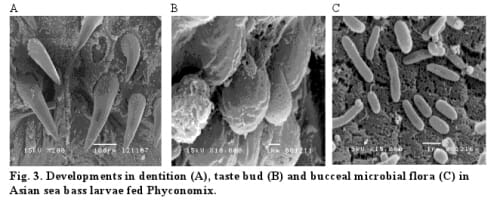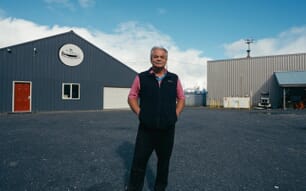The current study describes a novel, industrialised approach to negate these disadvantages and to place hatchery culture methods on a more consistent and stable platform. This strategy was designed and implemented by Meriden Animal Health of the UK and is presented in the form of the PHYCONOMIX range of products.
It is estimated that over 40 species of uni-cellular algae are in use in the aquaculture sector. They are generally recognised as difficult to grow in mass culture, particularly in low light (cloudy) or rainy conditions.
The most important factors to consider in algal culture are temperature, salinity, pH, light intensity, photoperiod and nutrient composition; the major expense in algal culture comes in the nutrient component.
Algae can require up to 17 different trace components in their culture medium. The cost of production is further increased due to the requirement for specialist technicians. Large scale culture increases the likelihood of breaches in bio-security, as pathogens can easily be transmitted from nearby culture tanks or via inadvertent introduction of insects etc.
Generally speaking, only one algal species tends to be cultured per single farmed species, therefore nutrient composition becomes a critical factor especially when algae is entering its decline and death phases, and composition can therefore vary widely.
Since single species algae cannot provide all of the nutrients required by larval shrimp and fish, careful selection of a range of algal species which cover the spectrum of larval nutrient requirements would seem a logical progression. Said species of algae can be grown in a sterile, hermetically sealed, bio-secure environment, then harvested at pre-determined times during the log phase of growth to optimise nutrient quality and consistency. Such algae can then be concentrated via centrifuge then packaged and stored prior to use.
Such a system is flexible in terms of algal composition in that formulations for fish and shrimp larvae can be tailored to meet the requirements of the larvae. These concentrates are easily stored and applied to tanks and can also be used to enhance and enrich living feeds such as rotifers and Artemia nauplii. Its use reduces the need for mass culture tanks which can then be turned over to larval and nursery rearing and also reduces demand on labour time and equipment.
Larval quality is improved and development is accelerated, resulting in healthier, stronger larvae which can be sold at a premium, thereby improving returns on investment. A trial was run comparing live Chaetoceros with a commercially available algal concentrate (Meridens PHYCONOMIX SHRIMP ZM) as food sources for larvae of the white shrimp (Litopenaeus vannamei) in Thailand.
There were three control treatments and three test treatments in each study group, tank size was 5MT and stocking density at nauplius was 200/litre. As well as their conventional feeds the test groups were fed on SHRIMP ZM two times/day to Mysis three and then three times/day to PL 15 following the manufacturers feeding instructions.
Survival, length, weight, length/weight ratio, gut/muscle ratio, feed consumption, hepatopancreatic Vibrio count, formalin stress test were all recorded during this trial. Scanning Electron Microscope studies of the harvested post-larvae were also conducted.
The accumulated data allowed for a return on investment calculation to be made between the use of live and concentrated algae during larval shrimp culture.
Effects of a multi species algae diet
By Zoea two an obvious size difference was noted (Li, pers. Comm.). At the same time, Controls experienced an outbreak of Zoea two Syndrome and a significant mortality occurred.
It was noteworthy that water quality in the test tanks was viewed as superior to that observed in live controls. This has been mirrored in other trials (Pota, pers comm.; Somhathai, pers.comm).

The mean survival of three concentrate treatments ranged from 80 – 88 per cent and was significantly higher than in the live controls (47-57 per cent). Animals are significantly greater in length, being 12.6mm in length compared to 11.3mm and significantly heavier (1.52mg compared to 1.43mg) than the controls, which resulted in a significantly more favourable length/weight ratio of 1.29 compared to 1.20. Body weight and muscle depth are consideredto be the most important factors in purchasing post larvae.

Feed utilisation seems superior in that the gut/muscle ratio favours muscle in the test groups (3.7 as opposed to 2.9) and this is manifested as an increased Artemia nauplius and flake feed consumption, which are 30-40 per cent higher in the test groups.
The final post-larvae are significantly stronger and more resistant to formalin stress as evidenced by survival rates of 100 per cent compared to 75 per cent in controls. Scanning Electron Microscope studies show significant differences in exo-skeletal structure and strength (Figure 1) as well as in development rate of the compound eye (Figure 2).
Such differences in stress survival and the structural improvement in the animals fed concentrates has significance to the grow out phase of farming operations.
Cost and return on investment figure prominently in any hatchery. The use of concentrates does in fact lead to more profitable production of post-larvae. This, coupled with the many advantages relating to ease of use make algal concentrates very attractive to hatchery operators.
A future for hatcheries
Anectodal evidence suggests that Zoea two Syndrome commonly experienced in many hatcheries is nutritional in origin but complicated by secondary invasion by bacteria or viruses (Li. Pers. Comm.).
This study, in which no outbreak was experienced in the test groups, would tend to support that premise. The nutritional profile of a multi-algal species diet will be more complete than a single species diet and this will aid in the protection of target animals.
The improved water quality using concentrates may simply be a function of improved shrimp larval health leading to improved vigour and appetite. It was noted feed consumption rates were higher but were non-detrimental to the larval environment.
In such an environment and with a much more complete, nutritionally balanced dietary regimen, it is not surprising that survival, growth, feed intake and resistance to stress are all significantly improved.
The developmental and structural advantages seen in the harvested post larvae are of considerable interest to grow out farmers.
In Fig. 1 an examination of the carapace by SEM reveals the carapace to be thin and pliable, and therefore more prone to damage. By contrast, the carapace of animals fed on concentrate appears much denser and stronger, and would therefore be capable of resisting much more handling stress. Such considerations are of vital importance to farmers.
Even in the case of the compound eye, the eye seems incomplete in the controls (Fig.2) and this will of course impact on feeding behavior. It seems in general the concentrate fed animals are more developed than controls and therefore more suited to the rigours of pond life.
Advantages are therefore not restricted to simple survival and growth. There are many subtle advantages that may escape direct attention but become evident on deeper study.
This developmental advantage is also observed in trials with concentrates in the nutrition of larval fish. In a recent study on larval sea bass (Lates calcarifer) apart from the advantages in terms of survival and growth, significant developmental acceleration was observed in development of dentition (Fig. 3a), taste bud (Fig. 3b) and buccal microbial flora (Fig.3c).

When factors such as ease of storage, ease of use, nutritional consistency, absence of potential pathogens, reduced labour cost and freeing of tank space are considered alongside the aforementioned performance superiority, the future of algal concentrates as a significant tool in hatchery culture seems secure.
Acknowledgements
The author would like to thank all concerned for their support during the development of the products and those involved in the demonstration of the product performance.




